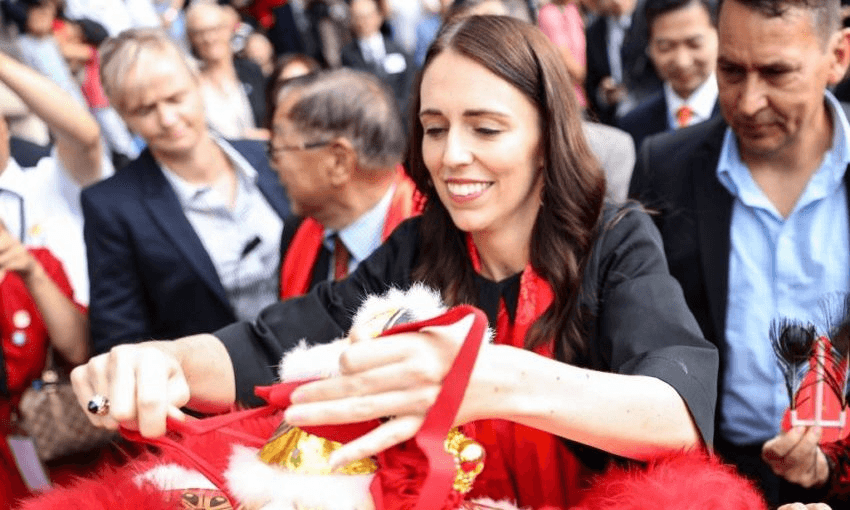As China sends abstract signals about its unhappiness with New Zealand, there are some concrete steps that Jacinda Ardern’s government can take, writes Robert Ayson of the Victoria University of Wellington Centre for Strategic Studies.
At the height of the Cold War, western intelligence agencies overanalysed who was standing next to whom at Red Square parades to discern the pecking order in the Soviet politburo. In 2019, something similar may be happening as people try to work out what a single passenger flight to Shanghai tells us about China’s attitude to New Zealand, if indeed it tells us anything at all.
When all the talk is about a deteriorating New Zealand-China relationship the natural tendency is to reach for that ready narrative. But our problem is that we don’t know quite how big the New Zealand-China problem is. Nor do we know the relative importance of the several potential causes of that problem. We’re stuck in a room of many mirrors, trying to work out which reflection is genuine.
Let’s start with what we can be quite sure about. First, it hasn’t taken the events of recent months to tell us that the golden summer in New Zealand China relations is over. That happy period following the completion of the Free Trade Agreement was bubble-wrapped in New Zealand’s reluctance to treat China as anything other than an economic opportunity. But even before the Key-English era had ended, New Zealand was raising concerns about China’s behaviour in the South China Sea. We eventually got the message that Beijing was unhappy when John Key was met in China with newspaper articles suggesting that Wellington should stay quiet if it wanted an FTA upgrade.
Second, the Ardern-Peters coalition government has accelerated New Zealand’s expression of concern about China’s behaviour, and at a pace faster than National is comfortable with. Last year’s Defence Strategic Policy statement released by defence minister Ron Mark offered the most concerted version yet of New Zealand’s criticisms of Beijing’s South China Sea behaviour. By the end of the year, China had joined Russia and North Korea as countries called out by New Zealand for nefarious cyber activities. Add in the GCSB’s assessment that a 5G bid from Spark including Huawei would not pass go, and it is fair to conclude that New Zealand’s stance on China has noticeably cooled. The security lens has surpassed the economic lens in the discussion.
Third, there is enough circumstantial evidence to indicate that China has been using more than words to communicate its displeasure with Wellington. For example, Beijing seems in absolutely no hurry to negotiate the upgrade which remains the cornerstone of NZ-China ties. Visits by leaders of New Zealand and China in both directions appear to be more difficult to arrange and schedules more difficult to negotiate. Even the Terracotta Warriors have felt the cold wind blow.
There is new friction in the relationship, and not all of it is accidental. But because that friction is often occurring behind the scenes it is still possible to claim that the relationship is fine, when that’s not really how things appear to be. In fact there are grounds for thinking that bilateral relations might become more difficult, especially if New Zealand decides (as it should) to raise stronger and more frequent concerns about China’s approach to human rights, including in Xinjiang.
In the midst of all of this supposing, we could all do with a bit more clarity on exactly what the problem in the relationship is, and what has caused it. As it might take a while for a leaders’ summit to be scheduled, we need to ask what Wellington can do in the meantime.
The first step is that cabinet ministers need to make New Zealand’s own doubts about Huawei more specific. The more these are presented as concerns about vulnerabilities that directly affect New Zealand organisations the better. More ammunition is needed against the popular view that New Zealand is acting simply because of its Five Eyes partnerships at a time when the US view is increasingly us-and-them. On the whole the coalition has not insulated itself from the charge that New Zealand sees itself as a willing member of a new Cold War. Addressing that problem means pushing back on treatments of the Huawei issue which regard any and all of China’s advances in information technology as an intrinsic threat.
But, second, this also means creating a sense of distance from the United States which in the Trump era has enjoyed a relatively easy ride from Wellington, especially in contrast to the treatment of China. Prime Minister Ardern made some helpful early admonitions that China remains inside New Zealand’s view of the rules-based order on trade and climate change, areas where Washington has been challenging New Zealand’s interests and values. But these have been drowned out by Winston Peters’ treatment of Trump’s America as New Zealand’s South Pacific saviour. The next time the prime minister refers to New Zealand’s independent foreign policy, it needs to be crystal clear this means some autonomy from the United States (as it did until recently) as well as from China.
This requires a third step, perhaps the hardest of all. The prime minister and her Labour colleagues need to assert greater influence on the way New Zealand talks about its foreign policy priorities. This means releasing the South Pacific reset from the absurd notion that it is all about containing China. It means giving clearer signals that New Zealand values the views of its wider Asia-Pacific partners, and not just western ones, in how to manage the China relationship. It means creating more opportunities for the trade and finance ministers to emphasise the value that New Zealand still attaches to the China relationship. And it may also mean a change in the pecking order within the politburo in Wellington.

